ATW90 – Hong Kong
Once again out of sequence, this is part of the series of articles being written for the book, Around the World in 90 minutes
Please send any comments or corrections to atw90@leohoenig.com
Please follow me on facebook (Leo Hoenig), Twitter (@leohoenig) or Instagram (@hoenigleo)
I am indebted to Christopher KL Lau, Editor and Photographer for www.offside.hk and https://wildeastfootball.net/ for providing invaluable background assistance to this article. The two web sites that Chris writes for provide an invaluable source of information in English for Hong Kong and Chinese Football respectively, (with Macau football also appearing on offside).
Following from India, I head back to China to meet the wife and boy again. They have booked into the holiday resort of Sanya, on Hainan Island for Chinese New Year. My flight times are not ideal, I have to change planes in Hong Kong. A flight from Mumbai, leaving at 2 a.m. gets there at 10.00, but the departure is not until 08.45 the next morning
On the other hand, there are Hong Kong League fixtures at 2.30 and 5.30 in the afternoon. I had visited Mong Kok Stadium, where the late match was being played before, but that was 26 years ago and the stadium was completely rebuilt in 2011. The other change in Hong Kong football was that on my earlier visits, only the Mong Kok and National Stadiums were used for the top level league, while now each team has its designated ground. There are still two clubs, Kitchee and Eastern sharing at the Mong Kok, while R&F play their games in mainland China. R&F are affiliated to Guangzhou R&F of the Chinese Super League
My flight is delayed before it starts, and then gets held in a holding pattern before landing in Hong Kong, so it is after 12 noon before I clear the airport. My hold luggage is checked through, so I save time in not having to wait for it, but this is, as I will discover only part blessing, and partly a curse.
The trouble is, that I have placed my coat in the bag. It has been 30o plus at the end of the India trip, and it will be around 25 in Sanya. I have been to Hong Kong several times in the past, including this time of year and the temperature has always been hot and humid.
It is 11o Centigrade when I arrive, and the temperature will barely rise (or fall) during my stay. Every local is wearing coats, while all I have is a double layer of short sleeved T-shirts.
My hotel has been chosen around my destination. I use the airport express train to Kowloon station, then one stop on the local metro and a short walk. I check in around one. After a little rigmarole with the room, I am out again within 30 minutes and arrive at the Sham Shui Po Sports ground just after two.
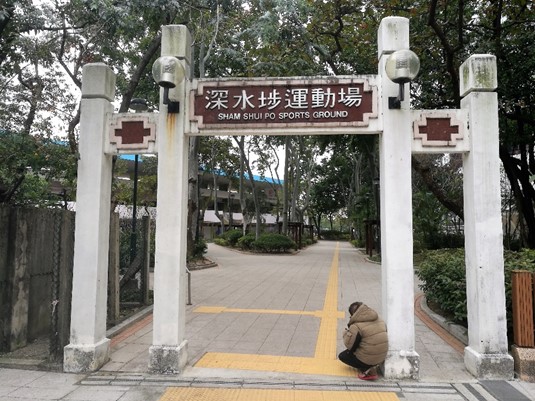
The ground is simple. It has an athletics track, and one covered stand with all concrete seats. The admission charge is HK$80, about £7. The capacity is shown as 2,194 and I guess it is that precise, as there is no route to go around the sides of the track and watch from outside the stand. It is a sports ground, with some other facilities outside the fences of the main stadium. The best feature is a small gate that marks the entrance from the road.
The home club here is Rangers, also known as Hong Kong Rangers, or thanks to the sponsorship as Biu Chun Rangers. They are currently bottom of ten in the league, not far enough adrift though that they cannot escape the single relegation spot. The visitors, Pegasus are also sometimes prefixed Hong Kong. They have had sponsors initials (JSW) or name (Sun) preceding the name in the past, but at the moment they are simply Pegasus.
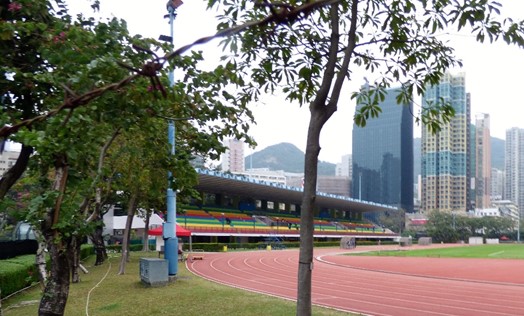
Pegasus are second in the league at the moment, but with an eight-point deficit and less than half the season to play, they are not likely to be able to stop Kitchee winning another title. Kitchee are the dominant force in Hong Kong football. This is the fourth season of the Hong Kong Premier League, and they have two titles and on runners-up prize to date. They also won the first division in three of the last four years that this was the top competition, again being runners-up for the other season. With participation in the Asian Champions League groups stages about to start, they have just signed Diego Forlan. The 38 year old Uruguayan had not had a club since playing for Mumbai City in the 2016 Indian Super League, but has scored five times in his first four matches in Hong Kong.
Pegasus start the game showing a little arrogance. It appeared that they believed that by turning up, they had already secured all three points. The leader of this opinion appears to be Awal Mahama. I have him down as right back, but he seems to be wandering all over the field, leaving his team very exposed at the back, with two very good chances to open the scoring mid-way through the half. First Chuck Yiu Kwok goes past the right back as if he isn’t there. (Well, actually, he wasn’t there) and beats another defender before forcing a save, and then a long shot hits the crossbar.
At the other end, it is the antics of Pegasus’ Ukrainian goalkeeper Oleski Shliakotin that grabs the attention. He appears to punch every ball that comes close, but not always in the right direction. At times, he looks comical, and an accident waiting to happen, but when a shot strikes a defender’s hand and the referee awards a very dubious penalty, he dives to his left to punch the ball away.
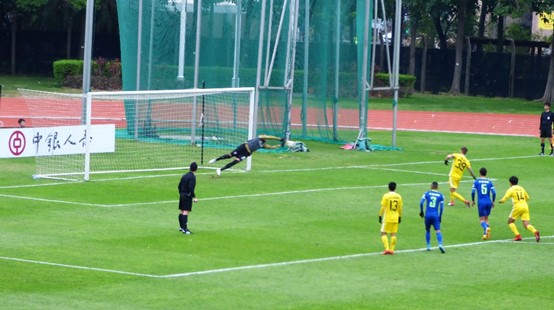
In the second half we have more of the same, but the Pegasus players have clearly been told during the break that to stop messing around. The formation is changed slightly, so as the right back slot is covered and Mahama can play his free reigning preference. The effect is almost immediate, as in the 47th minute Pegasus have two or three shots blocked, until the ball falls to the feet of Niko Komazec just outside the area, who strikes it back in the open the scoring.
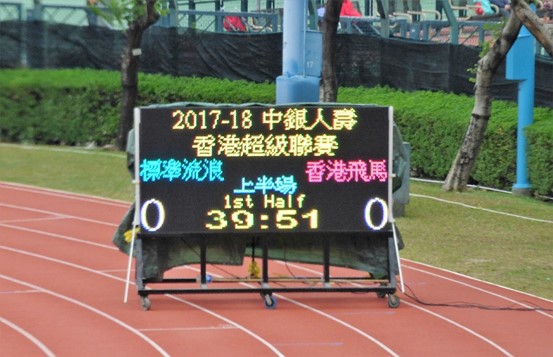
It is almost inevitable that Shliakotin would gift a chance at some point, and in the 66th minute he practically drops the ball at Mahama’s feet and it is 2-0. Five minutes later, Major receives a cross and makes up for his missed penalty. 3-0.
Rangers, who are not that bad a side and have contributed well to an entertaining game finally get a little reward for their efforts in the 78th minute when Marco Krasic converts a penalty.
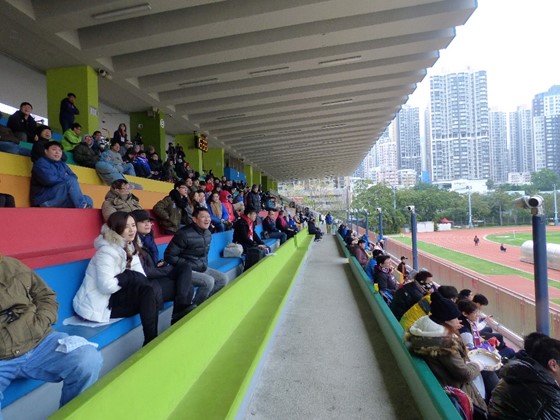
During the second half, I get to talk to a Hong Kong FA official who is acting as a match observer. I ask him about players such as Eugene Petit Mbende Mbone, who is not listed as a foreigner, but does not sound like a typical Hong Kong name. It turns out that he has been playing in Hong Kong since 2008, and that any player can apply for residence status after seven years, meaning they no longer count as a foreign player. They can then go on to apply for Hong Kong passport if they wish, making them eligible for the national team. When I look closer, it turns out that only three of the national team players starting their last Asian Cup qualifier were actually born in Hong Kong.
I know that in some countries, improved rankings by playing players that are not natives of the country has caused resulted in supporters feeling the team does not represent them, but Chris Lau tells me the opposite is the case in Hong Kong. “I believe quite a few fans support players who give up their own nation’s passports, which is a large sacrifice, to play for the national team. Former Hong Kong coach Kim Pan-Gon liked to select many of the naturalised players so it will be interesting to see what the new coach (unknown at this time) will do in the future.” Chris also says that it has not been these players that created a lack of opportunities for youngsters to come through the system in Hong Kong, but the attitude of families in Hong Kong, to always pressure their children to do well academically. “this means the number of local players coming through to be professional players is not as high as before. Given Hong Kong only has a few professional clubs then the opportunities to play are not very high either. Recently, with the rise in greater professionalism in Asian football and a shift in attitude, players see more chances to play across Asia and many youngsters are coming up the ranks so I believe we will see many more youngsters in the national team soon.”
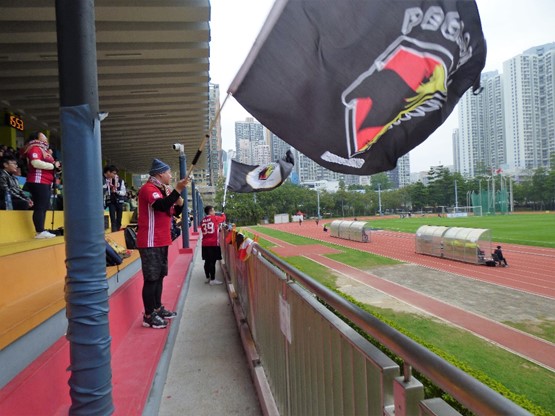
The high use of naturalised players goes some way to explaining why the Hong Kong team has moved up the rankings from a no-hoper to a team who could qualify for a major tournament, but does it also explain the drop in crowd figures. The HKFA officer drew a deep breath when the crowd was announced as 279.
When I looked up my previous visits to Hong Kong, in 1991 and 1995, the crowds were in excess of 5000 – and checking with a player who played during that era, it was confirmed that these crowds were typical, with league averages being at least 3000 per game over the season. Over the last decade, one can trace the league averages on the internet, and they have tended to be around the 1000 mark every season. The Chinese club, R&F do not draw much of a crowd, but tend to be excluded from the official figures. The numbers are always up slightly when Hong Kong FC are not in the top division, and down again when they are.
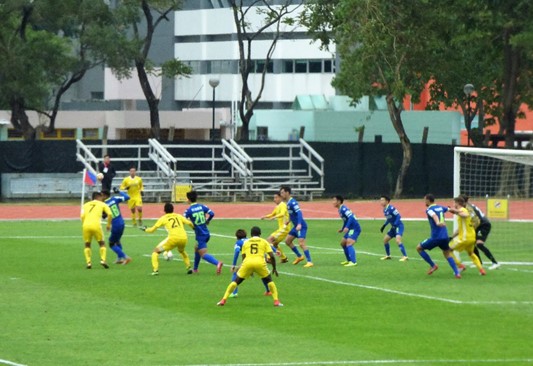
Hong Kong FC are a bit of an anachronism – despite the low crowds, the Premier League is a professional league, relying mainly on their owners to provide subsidies to pay the players. HKFC entered last season as a non-professional club, with players contracts worth just HK$1 (about 9p). While they could not compete, they are top of the lower division this season.
Even back in the 90s, they could not pull much of a crowd. The day before I saw a match at the Mongkok stadium with a crowd of at least 5000, I saw the club play at home in front of 142 in the same league. It appeared as the last bastion of white rule. While on the field the rules meant they had to play a minimum number of local players of Chinese descent, in the clubhouse the only Chinese faces were serving the drinks. I didn’t stay long.
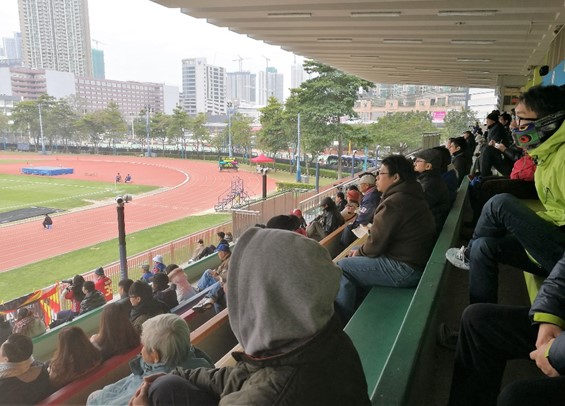
Drawing back to memories of my earlier visits, both involved a team known as Sing Tao who appeared to have a penchant for English keepers. The first time I saw them, they had Peter Guthrie in goal, and their opponent’s manager was quoted in the South China Morning Post as saying he was like giving his side a goal start, (they won 1-0). Oddly, I also remember the quote from a Spurs fan when Guthrie signed for them from Weymouth. At the time, Weymouth had six keepers on their books. “One for every day of the week except Saturday”.
When I went to the Hong Kong stadium in 1995, Maurice Munden was in goal, and kept a clean sheet. It had been the third time I saw him play that season. The other matches were for Ashford Town (Kent) in two different high scoring games. A 5-3 (after extra time) defeat at Fulham in an FA Cup First Round replay, and a 5-4 win in an away game against Wealdstone. I know I managed to speak to him briefly at the end of the game, and mentioned the contrast between Craven Cottage and the Hong Kong Stadium.
It seems Hong Kong has suffered a similar malaise in local club support to many other areas, as the world has become smaller and the television has taken control. Chris Lau again “Back in the fifties through to the early nineties, Hong Kong football games used to attract thousands of people regardless if it was a local league game or if teams came from overseas to play in friendlies. In that time period, Hong Kong football was considered as one of the best leagues in Asia if not the best [Editor’s note – results in the Asian Club Championship never supported this consideration, but then the AFC competitions were much less regarded at this time]. The league drew well-known overseas players such as Alan Ball (Eastern) and Arie Haan (Seiko) to the city which generated large crowds. Through those boom years, there were also many talented local born players like Leslie Santos, Ku Kam-Fai and Wu Kwok-Hung who remain household names and whom also drew in fans. Teams like Seiko, South China, Eastern were seen as the dominate teams in Hong Kong and any clashes between them would see full-houses.”
“The crowds began to dwindle and decline from the mid-nineties onwards with the advent of cable TV when games from England began to be screened live to Hong Kong (and the Asia-Pacific). This soon grew to include Serie A, Bundesliga’s, La Liga, etc and soon football fans could watch quality football at a touch of a button. Instead of going down to a stadium to watch a game, fans could see the best players in the world in the comfort of their own home.”
Another factor in the drop in attendances may be the disappearance of some teams. Sing Tao folded in 1999, while no less than five top division clubs decided against making the transition when the Hong Kong Premier League was founded four years ago. At the end of last season, South China FC took voluntary relegation for financial reasons. As one of the most successful clubs in Hong Kong history, this must have come as a shock to the establishment. With many of the teams still being part of commercial companies, and some coming and going without notice, it can be difficult for support to mobilise behind a team. Still, the recent moves where the teams now play across the territory may help in giving them a core group of fans.
There are still occasional big name signings that bring at least temporary boosts to the support of their club. The most prominent have signed in mid-season, making them available for Asian Club competitions and given a mid-season headline. This year it is Diego Forlan that has made the headline. In the past players such as Nicky Butt have featured. Butt finished his career with 13 games for South China in 2010-11. Five of the games were in the AFC Cup.
It should not have done. Hong Kong is running a professional league with very little marketing, no TV deal and very little identity. In the 1980s, the territory could hold its own – famously winning away to China in a 1985 World Cup qualifier. As I discovered in the 90s, the league could draw good crowds.
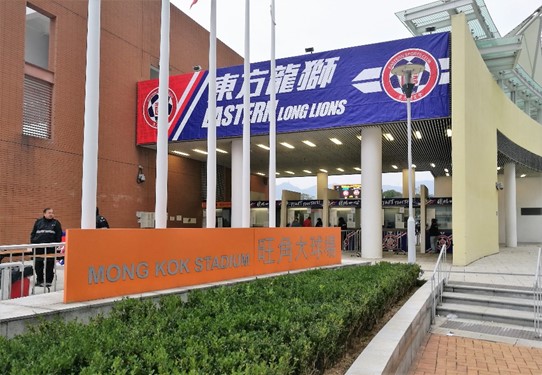
At about the time of the handover of the territory to China, Football was excluded from the Hong Kong Sports Institute, and the facilities to train young players was lost. It appears that the decline in the local sport can be dated back to this event. Although national team results have improved again recently, this may not be due to improved coaching of Hong Kong players, but the assimilation of a growing number of foreigners into the national team.
Even in Hong Kong, a territory that has always been a very welcoming to the incomer, this may well be a step too far. Both at club and national level, the teams provide little for the local to identify with. The World Cup home match against China was played at the Mongkok stadium, not the far larger Hong Kong Stadium, and yet was still a little short of capacity. Reports say the Hong Kong FA made it difficult for their regular fans to cross the border for the away match, (which the Chinese FA staged in the border town of Shenzhen). Instead of making tickets available to regular supporters, they were mainly allocated to corporate sponsors
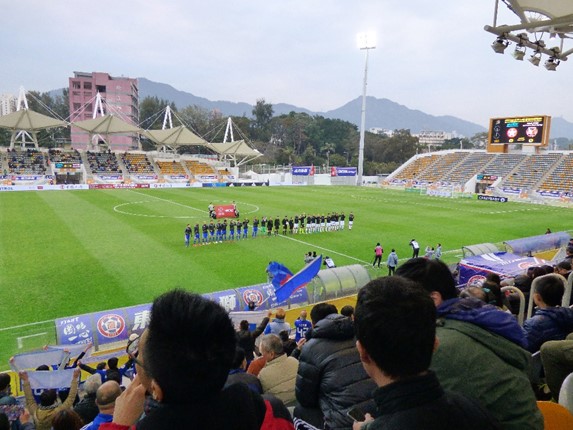
There are small fan groups wearing colours and waving flags at both stadiums I went to. Areas are allocated in the stand for these supporters, although neither Rangers (despite being the home club) or Yuen Long had any in evidence.
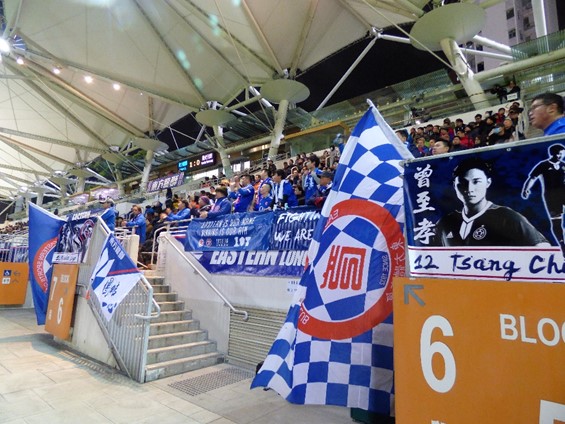
After the game had finished, I made my way to the Mongkok Stadium. The journey is quite simple, three stops on the metro with a short walk at each end. The stadium has been completely remodelled since I was last there, and while it actually cannot seat as many people, it does look better.
Unlike Sham Shui Po, which had practically no mention of the club from outside the ground, the Mongkok has been well clothed, inside and out as the stadium of Eastern Long Lions. The club name is just Eastern, with the sponsors title added on. It was even possible to buy a limited amount of merchandise outside the stadium. All of this must be removable, as the ground is shared with another Premier League club, and will be used for other events between match days.
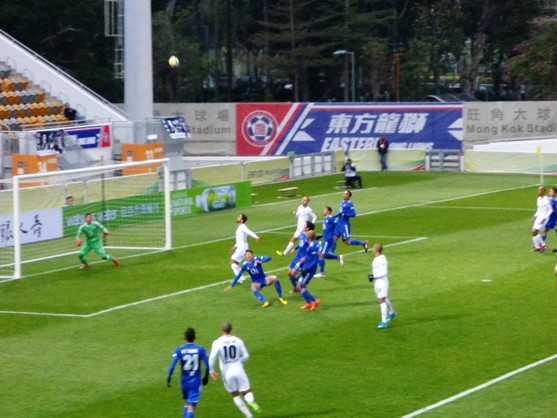
The renovation was done in 2011. The stadium has four sides, all built in a similar style. The two ends are uncovered stands, while there is a membrane cove stretched above the two sides. The stand on the northern side of the ground is significantly smaller than the south stand and the diamond shape of the cover must mean it would rarely protect the fans from rain or sun.
As for the game, it was not as entertaining as the first match of the day. Both of the teams involved are in the bottom half of the table, and neither seemed capable of really breaking through. The home side, Eastern (with branding, Eastern Long Lions) started well and a good individual move by Michel Antunes Lugo meant they took an early lead.

Despite their lower position in the table, the visitors Yuen Long (with branding, Sun Bus Yuen Long) had a much greater share of possession, but they tended to rely too much on their foreign contingent of four Brazilian players. The Brazilians in turn did not appear to trust the locals so much and hence were more predictable and it was easier to dispossess them before they became a danger. Still they managed more (mainly off-target) shots than the home side, and eventually got a player in the right place, at the right time to draw a foul (exaggerated off course by a dive). Everton Camargo scored from the spot to equalise, and the final result was 1-1. Meaning that there was no Hong Kong player, (true or assimilated) on the scoresheet of either game I saw
